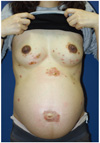Abstract
Pemphigus vulgaris is an uncommon, autoimmune disease characterized by acantholysis and blister formation in the skin and mucosa. Pemphigus vulgaris during pregnancy is exceedingly rare. The disease may be associated with adverse neonatal outcome, including prematurity and fetal death. The clinical features of this patient were similar to those of pemphigoid gestationis. Circulating antibodies directed at desmosomal proteins may cross the placenta and place children at risk for neonatal pemphigus. Transient skin lesions may occasionally appear in the neonate. We report a case of pemphigus vulgaris in a 32-year-old pregnant woman who showed erythematous bullae, erosions and crusts on the whole body. She was diagnosed by clinical and histopathological findings, direct immunofluorescent test. This patient was treated with high dose of corticosteroids to control the disease.
Figures and Tables
Fig. 1
Multiple erythematous to dark red, annular or targetoid macules and plaques on the abdomen, especially around the umbilicus.

References
1. Stanley JR. Freedberg IM, Eisen AZ, Wolff K, Austen KF, Goldsmith LA, Katz SI, editors. Pemphigus. Fitzpatrick's dermatology in general medicine. 2003. 6th ed. New York: McGraw-Hill;558–567.
2. Lynch PJ, Gallego RE, Saied NK. Pemphigus -- a review. Ariz Med. 1976. 33:1030–1037.
3. Terpstra H, de Jong MC, Klokke AH. In vivo bound pemphigus antibodies in a stillborn infant. Passive intrauterine transfer of pemphigus vulgaris? Arch Dermatol. 1979. 115:316–319.
4. Lee CW, Kim SH, Yu HJ. Pemphigus vulgaris developed during pregnancy. Korean J Dermatol. 1981. 19:99–103.
5. Lee CW. Autoimmune disease of the skin. 2002. Seoul: Academia.
6. Pisanti S, Sharav Y, Kaufman E, Posner LN. Pemphigus vulgaris: incidence in Jews of different ethnic groups, according to age, sex, and initial lesion. Oral Surg Oral Med Oral Pathol. 1974. 38:382–387.
7. Korman N. Pemphigus. J Am Acad Dermatol. 1988. 18:1219–1238.
8. Kaplan RP, Touloukian J, Ahmed AR, Newcomer VD. Esophagitis dissecans superficialis associated with pemphigus vulgaris. J Am Acad Dermatol. 1981. 4:682–687.
9. Wasserstrum N, Laros RK Jr. Transplacental transmission of pemphigus. JAMA. 1983. 249:1480–1482.
10. Chowdhury MM, Natarajan S. Neonatal pemphigus vulgaris associated with mild oral pemphigus vulgaris in the mother during pregnancy. Br J Dermatol. 1998. 139:500–503.
11. Harman KE, Albert S, Black MM. British Association of Dermatologists. Guidelines for the management of pemphigus vulgaris. Br J Dermatol. 2003. 149:926–937.
12. Virgili A, Corazza M, Vesce F, Garutti P, Mollica G, Califano A. Pemphigus in pregnancy. Acta Derm Venereol. 1995. 75:172–173.




 PDF
PDF ePub
ePub Citation
Citation Print
Print





 XML Download
XML Download